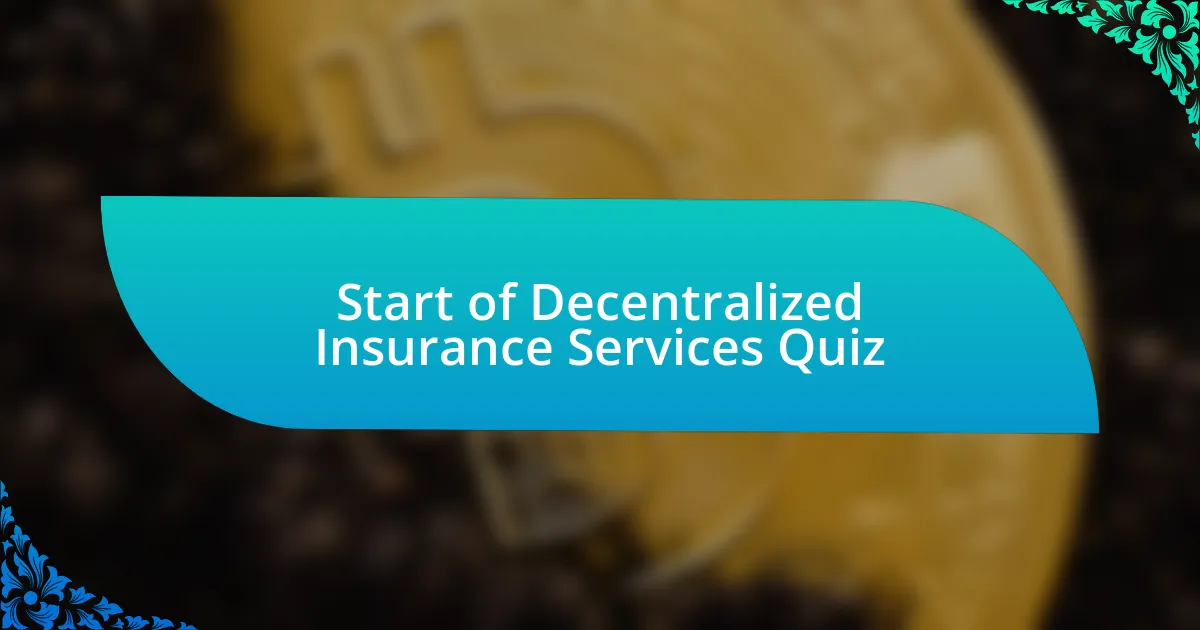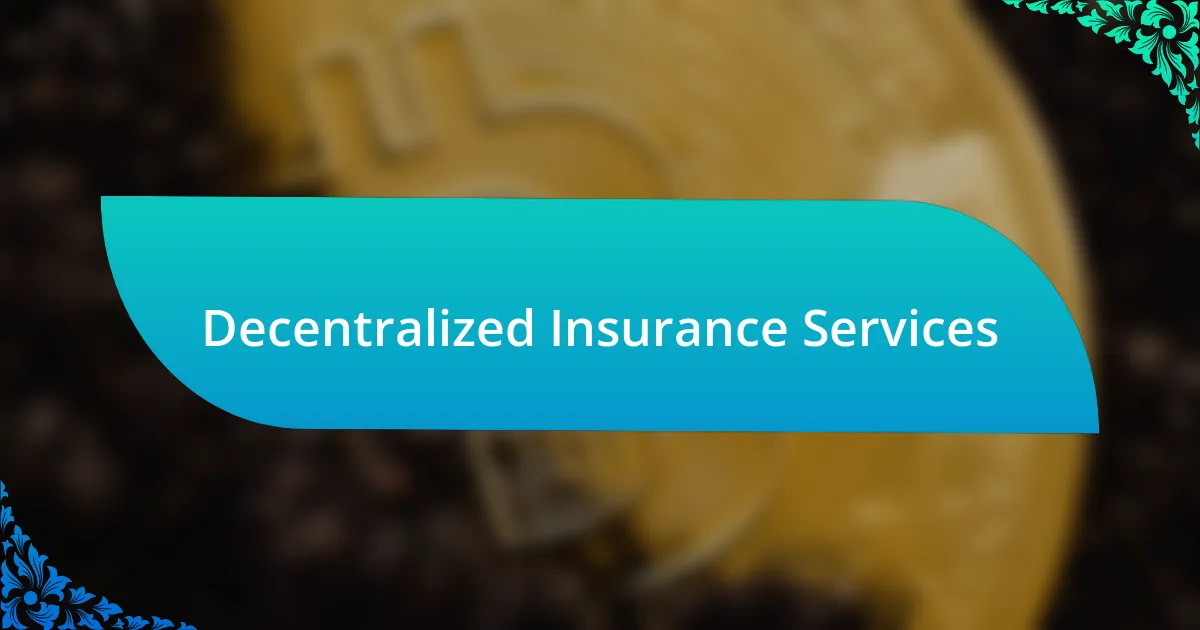
Start of Decentralized Insurance Services Quiz
1. What are decentralized insurance services based on Ethereum technology?
- General insurance
- Traditional insurance
- Tokenized insurance
- Corporate insurance
2. How do smart contracts initiate payouts in decentralized insurance?
- Smart contracts only issue refunds after inspection.
- Oracles verify data to trigger payouts.
- Users manually approve claim requests.
- Payments are made by traditional banks.
3. What makes decentralized insurance more transparent compared to traditional insurance?
- Transparency of transactions recorded on a public ledger
- Complicated policy conditions
- Use of middlemen to process claims
- Lengthy claims approval procedures
4. Why are oracles important for decentralized insurance on Ethereum?
- Oracles eliminate the need for smart contracts in insurance.
- Oracles reduce the amount of information needed for claims approval.
- Oracles create new cryptocurrencies for easier transactions.
- Oracles provide external information that ensures accurate claims processing.
5. How does decentralized insurance promote user trust?
- Decentralized insurance promotes trust through secretive practices and hidden processes.
- Decentralized insurance increases complexity and confusion among users.
- Decentralized insurance enhances trust among participants by providing a transparent and immutable ledger.
- Decentralized insurance relies on traditional intermediaries for transactions.
6. What role does community governance play in decentralized insurance platforms?
- Community governance allows policyholders to make collective decisions, enhancing control and transparency in the insurance process.
- Community governance eliminates the need for transparency, which can lead to trust issues.
- Community governance centralizes decision-making authority, reducing policyholder influence.
- Community governance restricts participation to insurance companies, limiting user involvement.
7. How do decentralized insurance services handle claim disputes?
- Claims are disputed in court like traditional insurance.
- Disputes are resolved through smart contracts and community voting.
- The insurer decides all disputes unilaterally.
- Disputes are ignored and claims are processed anyway.
8. What is the effect of real-time data on decentralized insurance claims?
- Real-time data has no significant impact on processing times in decentralized insurance.
- Real-time data complicates the claims process in decentralized insurance.
- Real-time data enhances transparency and speeds up claims processing in decentralized insurance.
- Real-time data increases the cost of managing claims in decentralized insurance.
9. In what way does decentralized insurance aim to lower operational costs?
- By eliminating intermediaries and automating processes.
- By increasing fees and manual operations.
- By reducing the number of claims processed.
- By relying on traditional brokers and agents.
10. How does risk assessment differ in decentralized insurance?
- Traditional insurance fully automates risk assessments with no human input.
- Decentralized insurance improves risk assessments using data analytics and smart contracts for accuracy.
- Decentralized insurance completely eliminates the need for data analysis in risk assessment processes.
- Risk assessments in decentralized insurance rely solely on subjective opinions and guesswork.
11. What advantages does tokenization provide for insurance transactions?
- Tokenization enhances transparency and security in transactions.
- Tokenization reduces the clarity in policy terms and conditions.
- Tokenization decreases transaction speed and efficiency.
- Tokenization eliminates the need for data verification entirely.
12. How does Ethereum enable peer-to-peer insurance solutions?
- By relying solely on traditional brokers for claims
- By using smart contracts to automate claims processing
- By creating physical insurance documents for users
- By limiting user involvement in insurance policies
13. What potential do decentralized insurance platforms have for algorithmic underwriting?
- Constrained coverage options
- Increased reliance on brokers
- Slower claim processing times
- Enhanced accuracy in risk assessment
14. How do decentralized insurance services support the gig economy?
- Decentralized insurance requires gig workers to pay higher premiums for coverage.
- Decentralized insurance gives gig workers guaranteed employment contracts with benefits.
- Decentralized insurance creates more complex claim processes for gig workers.
- Decentralized insurance reduces costs for gig workers by providing accessible coverage options tailored for their needs.
15. What technological advancements are crucial for the growth of decentralized insurance?
- Manual claim processing
- Smart contracts
- Traditional risk models
- Centralized databases
16. How does decentralized insurance address data privacy concerns?
- It utilizes blockchain to handle data securely and privately.
- It eliminates the need for any data protection laws.
- It shares personal data publicly on the blockchain.
- It requires all data to be stored in a central database.
17. What mechanisms prevent fraud in decentralized insurance schemes?
- Blockchain technology ensures claims authenticity.
- Policyholders make decisions based on intuition.
- Traditional agents verify claims manually.
- Centralized databases store all insurance records.
18. How are premium rates determined in decentralized insurance?
- Based on standardized criteria
- Through random selection
- By evaluating individual claims
- By pooling funds from policyholders
19. How can decentralized insurance adapt to changing regulatory environments?
- By refusing to comply with any regulations altogether.
- By utilizing adaptable smart contracts and compliance procedures.
- By solely relying on traditional insurance practices.
- By eliminating all external audits and reviews.
20. What implications does decentralized insurance have on microinsurance products?
- Decentralized insurance makes microinsurance products more complicated and less accessible.
- Decentralized insurance limits microinsurance options and raises premiums.
- Decentralized insurance enhances microinsurance by increasing transparency and reducing costs.
- Decentralized insurance restricts coverage to only high-income individuals.
21. In what ways does decentralized insurance empower marginalized communities?
- Decentralized insurance eliminates the need for any form of risk assessment altogether.
- Decentralized insurance primarily benefits wealthy individuals by enhancing luxury coverage options.
- Decentralized insurance expands coverage for marginalized communities by offering risk management solutions to individuals who were previously excluded from traditional insurance.
- Decentralized insurance is meant only for large corporations to manage their broad risks effectively.
22. What opportunities exist for innovation within Ethereum-based insurance markets?
- Manual claim processing and traditional brokers
- High commission fees and insurance agents
- Fixed premiums and exclusive policies
- Peer-to-peer risk pooling and automation
23. How does decentralized insurance facilitate global access to coverage?
- Decentralized insurance operates solely through centralized frameworks.
- Decentralized insurance expands coverage by including previously excluded individuals.
- Decentralized insurance is limited to a specific geographical region.
- Decentralized insurance only applies to large corporations.
24. How are loss calculations automated in decentralized insurance platforms?
- Claims are processed through centralized databases without blockchain technology.
- Insurance agents manually review claims for accuracy and compliance.
- Loss calculations are based solely on user-submitted data with no automation.
- Smart contracts verify claims using external information sources like oracles.
25. What are the challenges faced by decentralized insurance services?
- Lack of regulatory clarity
- Overwhelming market demand
- High expenses of marketing
- Insufficient technological resources
26. How can decentralized insurance models enhance customer loyalty?
- By requiring more third-party intermediaries for claims.
- By increasing the complexity of insurance processes.
- By limiting access to insurance policies for certain groups.
- By enabling direct communication between customers and providers.
27. What aspects of traditional insurance remain relevant in decentralized contexts?
- Dependence on brokers and agents
- Complex paperwork and regulations
- Transparency and security
- High premiums and lengthy claims
28. How does community consensus work in decentralized insurance governance?
- Community consensus relies on a single administrator who makes all decisions.
- Community consensus requires predefined policies that cannot be altered by participants.
- Community consensus involves collective decision-making and voting mechanisms among policyholders.
- Community consensus is achieved through random selection of insurance claims for payouts.
29. What impact do decentralized insurance solutions have on risk-sharing models?
- Decentralized insurance increases the monopoly of traditional insurers over the market.
- Decentralized insurance enhances transparency and cost-sharing among participants.
- Decentralized insurance limits participation to only a select group of high-risk policyholders.
- Decentralized insurance completely removes all forms of risk and uncertainty.
30. How are payouts ensured to be fair in decentralized insurance systems?
- Oracles provide external information sources that confirm payout criteria.
- Claims are manually reviewed by insurers for accuracy.
- Payouts are determined based on customer surveys.
- The system uses internal data exclusively without verification.

Congratulations on Completing the Quiz!
You’ve just wrapped up the quiz on Decentralized Insurance Services. We hope you enjoyed the journey! Engaging with these concepts is vital. You likely discovered how blockchain technology can transform traditional insurance models. Understanding risk management in a decentralized landscape is crucial in today’s digital age.
This quiz prompted you to think about the benefits of transparency and efficiency that decentralized systems offer. You may have learned about smart contracts, peer-to-peer networks, and how they can streamline claims processing. Such knowledge empowers you as a consumer and innovator in the insurance space.
We encourage you to delve deeper into this captivating topic. Explore the next section on this page, which offers comprehensive information about Decentralized Insurance Services. Expanding your understanding will enrich your insights and provide practical knowledge in this evolving field.

Decentralized Insurance Services
Understanding Decentralized Insurance Services
Decentralized insurance services refer to insurance models that operate without a central authority. They utilize blockchain technology to create a transparent, secure, and efficient system for managing insurance transactions. This technology enables peer-to-peer interactions among stakeholders, eliminating intermediaries and reducing costs. As a result, users can access insurance products directly, enhancing trust and engagement within the community.
Key Features of Decentralized Insurance
Decentralized insurance services typically feature smart contracts, which automatically enforce agreements based on predefined conditions. They also offer greater transparency, as all transactions are recorded on a blockchain accessible to all parties. This structure promotes fairness, minimizes fraud, and enhances claims processing speed. Additionally, users often participate in governance, influencing policy changes and service developments.
Benefits of Decentralized Insurance Models
Decentralized insurance models present several benefits, such as cost reduction through the removal of intermediaries. They enhance accessibility, allowing individuals in underserved regions to obtain coverage. Furthermore, the use of smart contracts ensures faster and more reliable claims processing. Participants also benefit from a sense of community, often incentivized by profit-sharing mechanisms that reward the collective for low claim activities.
Challenges in Implementing Decentralized Insurance
Implementing decentralized insurance services faces challenges, including regulatory scrutiny and compliance issues. Many jurisdictions lack clear regulations regarding blockchain and decentralized finance. Additionally, technical barriers exist, as stakeholders may require education on blockchain operations. There is also a need for robust security measures to protect against digital threats, which could undermine user confidence.
Instances of Decentralized Insurance Platforms
Several platforms exemplify decentralized insurance services, including Etherisc and Nexus Mutual. These companies leverage blockchain technology to offer unique insurance products. Etherisc allows users to create customized insurance plans, while Nexus Mutual operates on a mutual model where members pool resources to cover risks. Both platforms demonstrate the potential of decentralized insurance in real-world applications, enhancing awareness and adoption.
What are Decentralized Insurance Services?
Decentralized Insurance Services are insurance models that leverage blockchain technology to eliminate traditional intermediaries. These services use smart contracts to automate claim processing and underwriting, enabling direct interactions between providers and consumers. As a result, they foster transparency and reduce costs. The use of decentralized platforms also significantly mitigates the risk of fraud, as all transactions are recorded on the blockchain.
How do Decentralized Insurance Services work?
Decentralized Insurance Services work by utilizing blockchain technology to create a direct connection between policyholders and insurers. Smart contracts automate processes like premium collection and claim verification, ensuring that all agreements are executed only when pre-set conditions are met. This mechanism reduces human error and enhances efficiency. Additionally, decentralized governance models often allow stakeholders to have a say in policy decisions, increasing user trust and engagement.
Where can Decentralized Insurance Services be found?
Decentralized Insurance Services can be found on various blockchain platforms that support smart contracts, such as Ethereum and Binance Smart Chain. Numerous startups and projects operate in this space, offering a range of insurance products like property, health, and peer-to-peer coverage. Some notable examples include Nexus Mutual and Etherisc, which provide decentralized alternatives to conventional insurance offerings.
When did Decentralized Insurance Services emerge?
Decentralized Insurance Services emerged prominently after the introduction of smart contracts with Ethereum in 2015. The concept gained traction in 2017, coinciding with the growth of blockchain technology and initial coin offerings (ICOs). Over the following years, various projects began to explore decentralized models to address inefficiencies in the traditional insurance industry.
Who are the key players in Decentralized Insurance Services?
Key players in Decentralized Insurance Services include companies and platforms like Nexus Mutual, Etherisc, and InsurAce. These entities provide innovative solutions, enabling users to buy and sell insurance without centralized authorities. They often utilize community-driven models to engage users and align their interests with those of policyholders.

